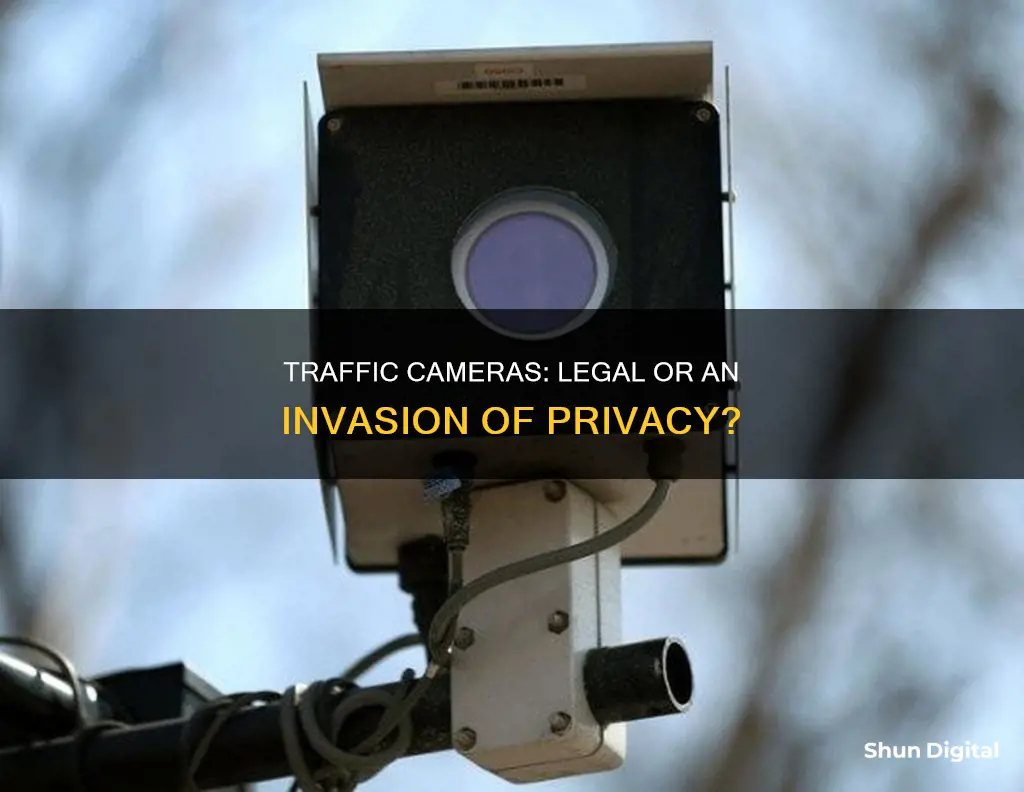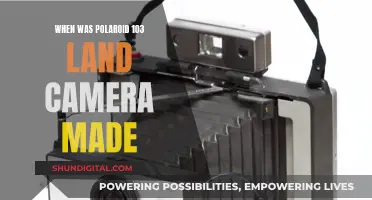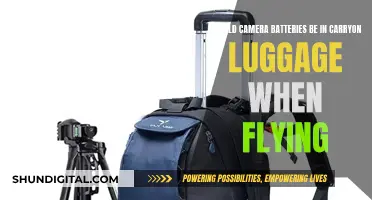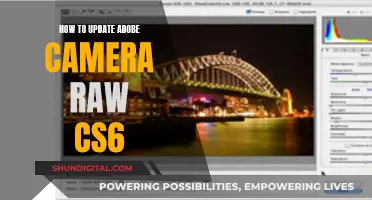
Traffic cameras are a type of automated enforcement technology used to detect and deter speeders and red-light runners. In the US, the laws concerning the use of traffic cameras vary from state to state. For example, in Washington, traffic cameras are permitted by state law and can be used to enforce red-light running and speeding in school zones. In Seattle, there are 31 red light traffic safety cameras operating at 23 different arterial intersections. On the other hand, some states, like Washington, have passed laws prohibiting the use of speed cameras. The legality of traffic cameras is a complex issue that differs depending on the jurisdiction and the specific circumstances of their use.
| Characteristics | Values |
|---|---|
| Speed and red-light cameras | A type of automated enforcement technology used to detect and deter speeders and red-light runners |
| Jurisdictions | Some use similar technology for other traffic violations, such as illegal rail crossings or toll violations |
| State laws | Many have enacted legislation permitting, limiting, or prohibiting the use of speed or red-light cameras at the state or local level |
| Enforcement | Can be limited to a particular area or community |
| Penalties | More lenient than those used with traditional enforcement, e.g. lower fines, no points assessed, or the citation not going on the driver's record |
| Localities | Some operate speed and/or red-light cameras even if the state does not specifically permit or prohibit it |
| Number of states permitting speed cameras | 19 states and the District of Columbia |
| Number of states prohibiting speed cameras | 9 states |
| Number of states permitting red-light cameras | 22 states and the District of Columbia |
| Number of states prohibiting red-light cameras | 8 states |
| State laws | Always subject to change through the passage of new legislation, rulings in higher courts, ballot initiatives, and other means |
| Traffic Camera Restrictions | Understanding specific laws could help appeal a traffic ticket; if a city installed a traffic camera against regulations, there may be a legal basis to challenge the photo evidence |
| Virginia State Code | § 46.2-882, passed by the General Assembly in 2020, allows for the “use of photo speed monitoring devices in highway work zones and school crossing zones” |
| Virginia code | 15.2-968.1, dating back to 2007, allows for the use of cameras at red lights |
What You'll Learn

Traffic cameras are legal in some states, but not all
The use of traffic cameras to enforce road safety is a highly controversial topic. While some states have embraced their use, others have not. This variation in state laws means that it is important to understand local laws before embarking on a journey.
Traffic cameras are used to enforce speed limits and traffic signals at intersections, with some states also allowing the use of stop-arm cameras on school buses. States that permit the use of traffic cameras include Arizona, California, Connecticut, Delaware, the District of Columbia, Florida, Georgia, and Louisiana. In these states, the use of traffic cameras is permitted either statewide or within specific jurisdictions. For example, in California, speed camera programs are allowed in some cities, while in Arizona, the use of cameras must comply with state standards.
On the other hand, some states have banned the use of automated traffic cameras altogether. For instance, Mississippi prohibits the use of automated recording equipment to enforce traffic laws, while Montana bans the use of automated enforcement systems to issue tickets. Other states, such as Arkansas, Nevada, and Utah, permit the use of traffic cameras in limited circumstances, such as in school zones, railroad crossings, or highway work zones.
The legality of traffic cameras is a dynamic issue, with state laws subject to change through new legislation, court rulings, and ballot initiatives. As such, it is always advisable to consult with an attorney or conduct legal research to verify the most current information.
Mastering Camera Raw White Balance
You may want to see also

Cameras can be used to enforce speed limits and traffic signals
Traffic cameras are an effective tool to enforce speed limits and monitor traffic signals. They are used to detect motoring offences, including speeding, vehicles going through a red traffic light, and unauthorized use of a bus lane.
Effectiveness of Traffic Cameras in Enforcing Speed Limits
Traffic cameras are an effective tool to enforce speed limits and ensure driver compliance. A worldwide review of studies found that speed cameras led to an 11% to 44% reduction in fatal and serious injury crashes. The UK Department for Transport estimated a 22% reduction in personal injury collisions and 42% fewer fatalities or serious injuries at camera sites. The British Medical Journal reported that speed cameras effectively reduce accidents and injuries and recommended their wider deployment.
Types of Speed Cameras
Speed cameras can be fixed or mobile. Fixed camera systems are usually housed in boxes, mounted on poles beside the road, or attached to gantries, overpasses, or bridges. Mobile speed cameras may be hand-held, tripod-mounted, or vehicle-mounted.
Effectiveness of Traffic Cameras in Monitoring Traffic Signals
Traffic cameras are also effective in monitoring traffic signals, such as red-light cameras. These cameras detect when a vehicle enters an intersection after the light has turned red and capture images or videos as evidence. A study in Scottsdale, Arizona, found a 50% reduction in total crash frequency and a 40% decrease in injuries due to red-light cameras.
Privacy and Legal Concerns
While traffic cameras are effective in enforcing speed limits and traffic signals, there are privacy and legal concerns. Some groups argue that the use of automated number-plate recognition systems can lead to mass surveillance of vehicle movements and, by association, the movements of the vehicle's owner. Additionally, there have been instances where private contractors operating traffic cameras have been accused of conflicts of interest and issuing erroneous citations.
Capturing Distant Subjects: Camera Focus Techniques
You may want to see also

There are different ways states implement enforcement cameras
The use of traffic cameras for enforcement is a highly controversial practice that has raised questions about public safety, privacy, and drivers' rights. States have different ways of implementing enforcement cameras, including:
Banning automated traffic cameras statewide
Some states, such as Mississippi, Montana, South Dakota, Texas, and Utah, have chosen to prohibit the use of automated traffic cameras for enforcement purposes. These states do not allow traffic cameras to be used for issuing citations or enforcing traffic laws.
Limiting how and where law enforcement can use cameras
Certain states permit the use of traffic cameras but place restrictions on their usage. For example, Arkansas allows cameras in limited circumstances such as school zones, railroad crossings, and highway work zones when a police officer is present. Nevada mandates that traffic cameras must be installed in law enforcement vehicles or facilities, or handheld by a police officer.
Allowing local governments to set up individual camera programs in their jurisdiction
Some states give local governments the authority to decide whether to implement camera programs within their jurisdiction. For instance, in Iowa, cities like Council Bluffs operate programs for speed enforcement and red-light cameras under local ordinances.
Permitting cameras statewide to enforce speed limits, traffic signals at intersections, or both
Other states have embraced the use of traffic cameras and permit their deployment statewide. Alabama, for instance, allows speed cameras within specific jurisdictions, and Arizona permits the use of cameras to enforce speed limits and red lights as long as they comply with state standards.
Lumina Cameras: Where Are They Manufactured?
You may want to see also

Some states have specific locations where cameras are permitted
The use of traffic cameras is a highly controversial topic in the US, with many states having different laws and regulations surrounding them. While some states have chosen to ban automated traffic cameras altogether, others have implemented specific restrictions on how and where law enforcement can use them.
Some states, like Washington, have specific locations where traffic cameras are permitted. In Washington, traffic cameras are allowed in school zones, public park zones, hospital zones, and other locations of concern. The state recently expanded its use of speed cameras to include highway work zones. Before installing cameras, cities and counties in Washington must gather data to justify their use at a particular location and post notices publicly for 30 days before turning them on.
In Alabama, speed cameras are permitted within specific jurisdictions such as Center Point and Midfield. Similarly, in Arizona, the use of cameras to enforce speed limits and red lights is allowed as long as it complies with state standards. On the other hand, states like Arkansas only permit the use of cameras in limited circumstances such as school zones, railroad crossings, and highway work zones when a police officer is present.
In summary, while the use of traffic cameras varies from state to state, some states have chosen to permit their use in specific locations, taking into account factors such as public safety, privacy, and drivers' rights.
Polaroid Snap Camera: What Battery Type?
You may want to see also

There are legal challenges to the use of traffic cameras
The legality of traffic cameras is a highly controversial topic, with many states enacting legislation permitting, limiting, or prohibiting their use. While some states have embraced the technology as a means to enforce traffic laws, others have raised questions about public safety, privacy, and drivers' rights.
There are indeed legal challenges to the use of traffic cameras. One notable example is the case of Missouri vs. McNeely, where the Missouri Supreme Court ruled that automated traffic enforcement programs were unconstitutional unless the state could provide proof of the driver's identity at the time of the offense. This ruling set a precedent for other states to follow, and it has had a significant impact on the implementation of traffic cameras across the country.
Another legal challenge to the use of traffic cameras relates to the issue of privacy and the protection of personal information. In some states, there are strict laws governing the use and disclosure of information collected by traffic cameras. For example, in Washington State, there are detailed regulations regarding the placement of traffic cameras, the use of flash, and the protection of drivers' and passengers' identities. The state also has strict requirements for the processing of traffic camera infractions and the use of revenue generated from fines.
Additionally, some states have specific restrictions on the use of traffic cameras. For instance, Arkansas only permits their use in limited circumstances such as school zones, railroad crossings, and highway work zones when a police officer is present. Similarly, Utah has limited the use of traffic cameras to school zones, roads with speed limits of 30 mph or less, and when a local ordinance allows them.
The legality of traffic cameras is a complex and evolving issue, and it varies from state to state. While the technology has been touted as a way to improve road safety and change driver behavior, there are also valid concerns about privacy, equity, and the potential for abuse. As a result, it is important for communities to be engaged in the planning and implementation of such programs and for there to be transparency around their impact.
Disabling Home Surveillance: Tips to Interfere with Cameras
You may want to see also
Frequently asked questions
In the US, the laws regarding traffic cameras vary from state to state. Some states have passed laws that permit the use of traffic cameras, while others have prohibited their use. Ultimately, it is up to local governments to decide whether or not to deploy cameras and where to place them.
Traffic cameras are permitted by state law in 19 states and Washington, D.C. These include Washington state, where they are used in cities like Seattle.
Traffic cameras are prohibited by state law in 9 states for speed enforcement and 8 states for red-light enforcement.
Traffic cameras are intended to improve road safety and reduce accidents by enforcing speed limits and red lights. They can also be used to enforce bus lanes and reduce illegal racing.







